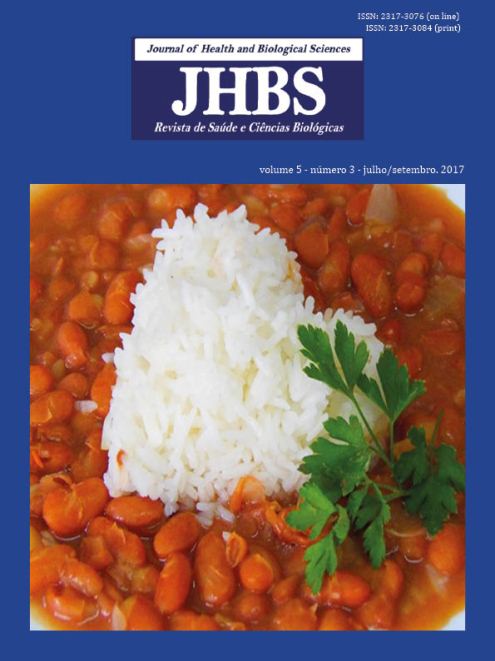Assessment of the quality of life of elderly with diagnosis of oral squamous cell carcinoma submitted to combined modality therapy
DOI:
https://doi.org/10.12662/2317-3076jhbs.v5i3.1352.p213-220.2017Palavras-chave:
Elderly, Mouth neoplasms, Quality of life, Combined modality therapyResumo
Introduction: Evaluating the quality of life allows a more accurate clinical control as well as the provision of prognostic information for specific groups. This study was designed to evaluate the quality of life of elderly diagnosed with oral squamous cell carcinoma submitted to combined modality therapy. Methods: This is a retrospective and observational study, with cross-sectional quantitative character. A total of 206 records of patients with head and neck cancer treated between April 2013 and October 2014 were analyzed. Eleven patients over six months of treatment completion were included in the study. The questionnaire of quality of life of the University of Washington (UW-QOL) was applied. The data were collected regarding the social-demographic, clinical-pathological and therapeutic profiles, and the non-stimulated salivary flow was measured. Statistical analysis of quantitative data was performed by the Spearman nonlinear correlation, considering a confidence of 95%. Results: Chewing, saliva and speech showed the lowest scores (31.8; 42.3; 60.6, respectively). Statistically significant correlation was found between: shoulder and mood (r=0.787); swallowing and chewing (r=0.761); completion time of radiotherapy and recreation (r=0.659); activity and recreation (r=0.653); pain and swallowing (r=0.626); chewing and speech (r=0.607); age and speech (r=-0.617). Conclusions: Elderly with oral squamous cell carcinoma diagnosis sunmitted to combined modality therapy presented the areas related to chewing, saliva and speech as the most committed ones. Older individuals have greater impairment of speech, as well as those with longer completion of radiotherapy have better results related to the recreation area.Downloads
Não há dados estatísticos.
Downloads
Publicado
2017-06-30
Como Citar
1.
Marinho EB, Mota MRL, Alves APNN, de Moura JFB, Sousa FB. Assessment of the quality of life of elderly with diagnosis of oral squamous cell carcinoma submitted to combined modality therapy. J Health Biol Sci. [Internet]. 30º de junho de 2017 [citado 20º de agosto de 2025];5(3):213-20. Disponível em: https://periodicos.unichristus.edu.br/jhbs/article/view/1352
Edição
Seção
Artigos Originais
Licença
Copyright (c) 2017 Erasmo Bernardo Marinho, Mário Rogério Lima Mota, Ana Paula Negreiros Nunes Alves, José Fernando Bastos de Moura, Fabricio Bitu Sousa

Este trabalho está licenciado sob uma licença Creative Commons Attribution-NonCommercial 4.0 International License.


















